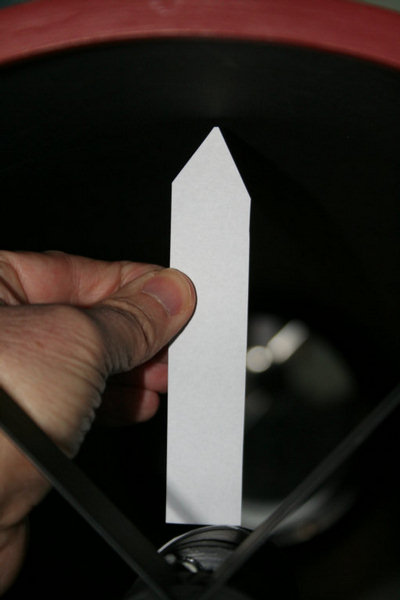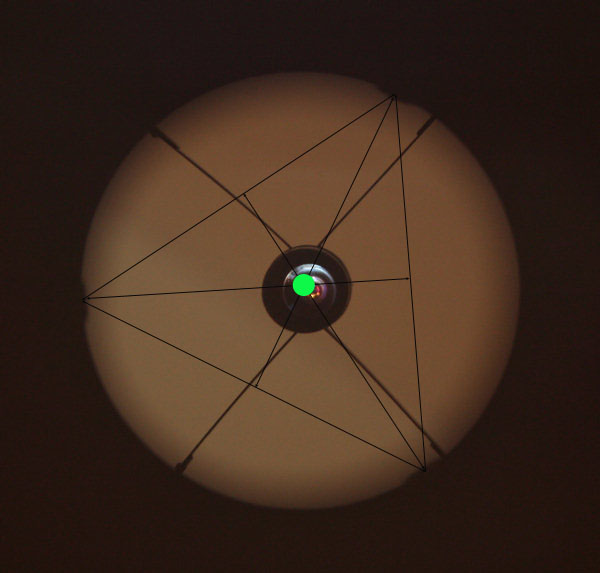| Collimation |
10th December 2008Collimation issues I suspect that my 10" scope has collimation problems. After advice from Chris Livingstone, I made a paper mask for the secondary mirror.This has a small hole in the true centre of the elliptical flat.  A laser collimator placed in the focusing tube shows that the focusing tube is not aligned with the centre of the secondary. (Picture taken by holding a mirror inside the scope tube).  This shows that the focusing tube is off by at least 5mm. This could be due to the scope tube not being truly circular, and hence a misaligned focuser, or perhaps the secondary mirror in its supports is not in the centre of the tube. How to tell which is which? The next two pictures show a strip of paper used to measure the distance between the edges of the secondary and the inside of the scope tube.The pointed end of the paper is held just touching the inside of the tube. The second picture shows that the secondary is indeed displaced, by an amount that agrees with how far the laser was offset from the secondary centre. 
 To check the circularity of the tube I placed a strip of paper around the inside of the tube with a line to show the point opposite the focuser. The laser dot is very close to the line so there seems to be no problem with the alignment of the focuser.  Each vane of the spider has a nut which, when loosened, allows the vane to be adjusted. All that is needed is to remove the matt black paint from the nut and free the vanes. Then the secondary is adjusted until the laser beam hits the hole in the paper mask. Because it doesn't touch the paper it doesn't show up in this picture. However, the laser dot could be seen hitting the centre of the main mirror, which is where it should be.  The view down the focussing tube. This is without adjusting the main mirror to return the laser dot to the collimator. Nevertheless, all three primary mirror fastening clips can be seen, which was not possible before. The red and yellow lights in the centre are inexplicable. They seem to be coming from inside the camera! When perfectly collimated the reflection of the secondary should be concentric with the green dot. The next step is to place a paper disc in the centre of the primary mirror where the green dot is. This will allow more accurate collimation as the centre of the mirror is difficult to judge by eye. 
29th December 2008The centre of the 10" mirror needs to be marked to enable accurate collimation. See this section30th December 2008With the centre of the primary mirror marked by a ring binder reinforcement, accurate collimation can be done. The laser collimator was placed in the focusser and the laser dot aimed at the centre of the mirror. The primary was adjusted to return the laser beam to the centre of the collimator.Visual confirmation of collimation was made using a simple aluminium plug with a small hole in it. Viewing through the hole should confirm that the important parts of the optical system are in alignment.  This is the view through the collimating plug. The smallest circle is the outline of the ring reinforcement. The next ring is the outline of the collimating plug. The large circle is the outline of the main mirror. The three circles are concentric. Note that the reflection of the secondary mirror and its supports is not quite concentric with the other elements. This should not have much impact on the quality of images. (In fact, some people say that the secondary should be offset a small amount).  |